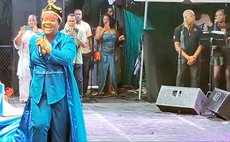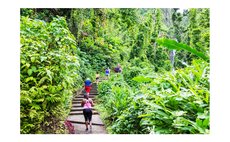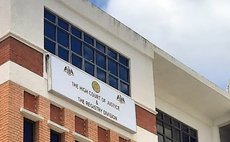No Entry for Dangerous Banana Disease
Close the gates; keep the enemy out. Cooperate. Plan ahead. And take no prisoners?
If this sounds like battle strategy and language, you're probably right. At least that's the impression crop protection officials present as the agricultural sector prepares for a fight with a new dangerous enemy, Fusarium wilt TR4, which is threatening banana production in Dominica and the Americas.
Recently the Food and Agriculture Organisation (FAO) of the United Nations urged countries to step up action against that destructive banana disease following its spread to Africa and the Middle East. And Dominica is apparently heeding that advice.
"This is a more potent and dangerous disease," Ryan Anselm, Dominica's Crop Protection Officer told the media at a press conference last Wednesday. "There's no cure; there's no chemical that can manage the disease."
Anselm said that although the Caribbean and Central America are still free from the wilt "there's the potential for it to be introduced and spread".
"Once it enters your country it can stay in the soil for a number of years; so there will be no banana and plantain production in that area for many years," he said.
Anselm said the Ministry is in the process of developing an emergency action plan that will outline strategies to deal with the potential danger.
Undoubtedly, this strategy will involve close collaboration with banana growing regions in the Americas as well as the strengthening of plant quarantine strategies here in Dominica to prevent the fungus from getting here.
"We are asking everyone to be on board. It cannot be a Ministry of Agriculture strategy alone; it has to be a national one because everyone is involved," Anselm said. "If you entered a farm in Africa even in China, Asia where the disease is present you have to wash out your shoes, disinfect your clothing. And inform us if you entered a farm in these areas".
In the case of Fusarium wilt TR4, man is the main agent for spreading the fungus, Anselm said.
"Diseases cannot buy an air-plane ticket and come to your country; it has to take someone to bring in infected material or plant parts that is infected or shoes or clothing," he said.
Anselm said a border control management committee may be formed soon to work at improving the control of Dominican ports.
Asked how would he console farmers who over the years have been inundated by reports of dangerous pests and diseases, from Black Sigatoka to Giant African Snails to Huanglongbing to Tristeza, the crop protection officer suggested that farmers may have to get used to these reports as climate change, increased international trade and travel create the opportunity for the presence of more dangerous and exotic pest and disease species.
"Right now somebody can go to China in three days, go and come back; in the past it took six weeks to go to China and return," he said. "People are (also) more dishonest; people are smuggling more things."
He added: "It's going to be a challenge" to control pests and diseases especially since resources are "not always available".
#### Your title here...Update on the control of Black Sigatoka
While crop protection technicians look over the horizon for the possible appearance of the Fusarium wilt TR4, the battle to control Black Sigatoka continues. That battle has been on for two years.
Black Sigatoka is considered the most destructive disease of bananas and plantains and is caused by the fungus Mycosphaerella fijiensis. It first arrived in the Caribbean in 1991, and has since established and spread throughout the region. Severely infected leaves die, significantly reducing fruit yield and causing mixed and premature ripening of banana bunches. Black Sigatoka arrived in Dominica in July 2012 and since then it has spread to practically all regions of the island.
"Basically it is over the whole island but it's certainly not widespread in the North," said Carol Severin-Abraham, the Coordinator of the Black Sigatoka Management Programme.
Severin-Abraham said at the end of the 6th spray cycle technicians had sprayed about 940 acres of bananas and approximately 1000 acres of plantain. And the disease is affecting the number of established acres of bananas.
"What we have seen is slight drop in the total banana acreages, compared to the previous cycle, but at the same time we see people continuing to plant plantain," she said. "So in spite of Black Sigatoka, the plantain acreages are going up."
Severin-Abraham believes that training her programme conducted over the past year is beginning to bear fruit as farmers practice correct control measures.
"I think farmers are getting the message," she said.
Asked whether Dominican farmers will be able to effectively manage Black Sigatoka in the future, Severin-Abraham said: "When I see what's happening in Martinique where they have many more acres than we do, a lot more Black Sigatoka and total control, I have to have hope."
And additional assistance is expected from the Government of Dominica to help reduce the spread of the fungus.
"With support from the National Employment Programme we are to employ 21 individuals; that is seven supervisors and 13 labourers to really target these abandoned fields," Anselm said. "The abandoned fields are a source of inoculation so we have to get rid of most abandoned fields."
Anselm added: "So the programme is moving, not smoothly, but relatively good. There are resource problems that we can always identify with, we are a small developing state.
But in the medium and long term the agricultural sector will have to introduce resistant varieties to both Black Sigatoka and Fusarium wilt TR4. And Cuba may help.
"We have identified Cuba to be the most suitable country in terms of phytosanitary concerns that will give us disease free resistant varieties," said Anselm.




